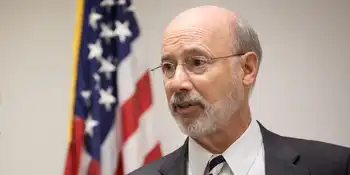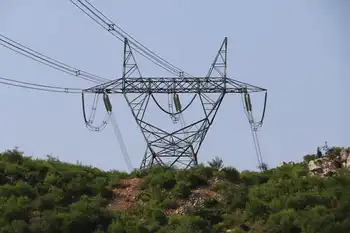Artificial trees that harvest the sun and wind for power
By Scientific American
NFPA 70e Training
Our customized live online or in‑person group training can be delivered to your staff at your location.

- Live Online
- 6 hours Instructor-led
- Group Training Available
Van der Beek — whose previous professional experience was teaching alternative medicine — founded Solar Botanic, Ltd., in London last year on the concept. Solar Botanic's ambitious plan involves bringing together three different energy-generation technologies — photovoltaics (aka solar power, or electricity from visible sunlight), thermoelectrics (electricity from heat) and piezoelectrics (electricity from pressure) — all in the unassuming shape of a leaf on its stem.
Place thousands of these units, dubbed nanoleaves, on a natural-looking, though fake plastic tree — and one could have electricity production without spoiling natural landscapes, van der Beek says.
In addition to solar power, as rustling wind or falling rain disturbs the false leaves, nanogenerators in their petioles — the stalks connecting them to a branch — could generate small amounts of piezoelectrical power, van der Beek says. And thermoelectrics, like photovoltaics, take advantage of the sun, but rather than harvesting light, it converts the low-energy waves we feel as heat into electricity.
At present, Solar Botanic is exploring several designs, from palm trees to broad leaves as well as flowers and shrubbery. Van der Beek predicts a tree with a canopy 20 feet (six meters) in diameter that provides a surface area of roughly 1,200 square feet (110 square meters) could power an average home, whereas groves of them could make ample amounts of electricity in and around population centers. "These trees could help avoid the long land lines that bring electricity to cities and homes," van der Beek says.
Solar Botanic hasn't settled on materials, but the nanoleaves would likely rely on highly efficient, thin-film solar cells, perhaps made of copper indium gallium selenide (CIGS), to convert sunlight into an electric current, van der Beek says.
Installation of an energy harvesting tree, van der Beek says, would simply require drilling a hole and then anchoring the extended tree trunk and base in the ground. The branches would go on much like those of an artificial Christmas tree, segment by segment. Should a section or leaf get damaged, customers could swap it out for a new or repaired piece of hardware, says van der Beek. Power lines running underground would bring the energy to a home or a central power storage area; inverters for turning the direct current generated by the faux tree into usable alternating current could go in the trunk or a nearby dwelling.
Van der Beek envisions the trees lining roadways, trapping heat and capturing the whirling winds of passing tractor-trailers. Artificial trees with electrical outlets in mall parking lots could charge electric vehicles while the owner shops, he says.
The company's "trees" would approximate the real thing as closely as possible. "We want to keep the outside resembling a natural tree, so that means no nuts and bolts," van der Beek says. Though the trunk would be made primarily of recycled materials including plastic bottles and car tires, van der Beek says it would also contain liquefied waste biomass — wood — processed via a steam-combustion technique developed at the State Institute of Wood Chemistry in Riga, Latvia. "The result is a fluid product that we mold into any form we like, so therefore we should be able to create trees that look, feel and smell like real wood," van der Beek says. The leaves wouldn't be shiny like a solar panel, either.
Zhong Lin Wang, a nanotechnologist at the Georgia Institute of Technology, likes van der Beek's proposal. "The shape of the leaf of a tree is the ideal shape to capture the power of the sun," Wang says. "I think the Solar Botanic idea could have tremendous potential." Wang and his Georgia Tech colleagues have demonstrated the potential of piezoelectrical generation on a small scale by developing nanowires that could be woven into fabrics, generating electricity as the wearer moves, to power an iPod, for example.
But other scientists are skeptical. "A lot of people are trying to catch the green energy wave, and sometimes it's half-baked science," says Michael Woodhouse, a solar energy materials scientist at the National Renewable Energy Laboratory (NREL) in Golden, Colo.
For one, could solar and thermoelectrics really work together on a single leaf blade? Joseph Heremans, a professor of mechanical engineering and physics at The Ohio State University in Columbus, says that's "spatially problematic, to say the least." Van der Beek recognizes this as probably the chief remaining engineering hurdle, saying "We do have to find a symbiosis between these materials [photovoltaics and thermoelectrics].... They can't get in each other's way."
Then there's the efficiency of green solar panels: "If Mother Nature wanted photosynthesis to be efficient, she would have made leaves black," Woodhouse says. Black materials absorb all of the sun's visible light, explaining why solar panel makers opt for pitch rather than designer colors. Van der Beek concedes Solar Botanic may have to settle for a dark shade of green, but he believes that ever-improving photovoltaics will make energy generation that sacrifices some reflected green wavelengths economical.
And it is unclear how much the thermoelectric component of the trees will contribute, Heremans says. The temperatures required for real thermoelectric power generation in those environments vastly exceeds the heat that green leaves in the sun normally experience. "I don't see [nanoleaves] working with small temperature gradients," he says. "The second law of thermodynamics tells you that small gradients equal poor efficiency." Van der Beek acknowledges that this third component would contribute the least to the overall energy equation.
Still, he hopes to have a working prototype in about three years. "I know this might still be far off," van der Beek says, "but we have the energy and the will to do this." Including van der Beek, Solar Botanic has four full-time employees, patents pending in several countries (a U.S. filing is in the works), and has secured funding from California-based investors (he won't say how much). Technical assistance for Solar Botanic has come from the nonprofit, England-based Center for Sustainable Engineering as well as the University of Reading–backed Biomimetics Network for Industrial Sustainability (BIONIS), he says.
All told, an energy harvesting tree with a 20-foot-diameter canopy is expected to cost between $12,000 and $20,000, van der Beek notes, and would produce about 120,000 kilowatt hours over a 20-year life span. As such, each kilowatt-hour would cost about 13.5 cents — not particularly competitive with most power sources, which are average around 5 cents.
The company's trees would resemble real trees so closely, says van der Beek, that birds may be tempted to visit. And other animals, as well: "Our trees would be safe for dogs and humans," van der Beek says, "if they have to take a pee." That is good — an artificial forest populated by electrocuted birds and dogs would most likely short-circuit this project.











